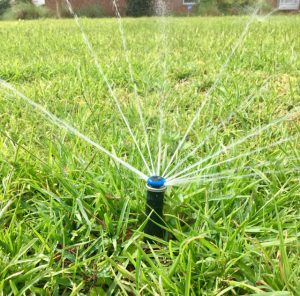Calibrating or determining the rate of water your sprinkler system applies is an easy job.
Here’s how to do it:
- Obtain 5 to 10 straight-sided empty cans such as tuna fish or soup cans.
- Place the containers randomly within the irrigated area so that they catch the water when the irrigation system is running. This needs to be done for each irrigation zone, separately.
- Turn the water on for 15 minutes.
- Use a ruler to measure the depth of water in each can. The more exact your measurement, the better your calibration will be. Measurements to the nearest 1/8 inch are adequate.
- Determine the average depth of water collected in the cans (add up the depths of water measured in each can and then divide by the number of cans).
- To determine the irrigation rate in inches per hour, multiply the average depth of water times four. For example, if you collected an average of ¼ inch of water in the cans as a result of letting the irrigation run for 15 minutes, the irrigation zone would need to run for 30 minutes to apply ½ inch of water, or 45 minutes to apply ¾ inch of water, etc.
It’s best to do this calibration exercise during the same time of day the system normally runs so that water pressures are similar.
Here’s why calibrating your system is important.
When a timer/controller is set to come on frequently for short intervals of time (every other day for 20 minutes for example), the result will be a shallow, weak root system and a lawn that becomes dependent on its shallow roots being watered frequently. Also, watering frequently benefits certain weeds such as dollarweed and nutsedge while weakening the lawn.
To develop a deep, strong root system and a lawn that will go through hot, dry weather in better shape without requiring water as often, switch the automatic timer to manual.
Watering a lawn on an as needed basis is the best way to water correctly and develop a deep-rooted lawn. This is the reason for calibrating your irrigation system. You should apply ½ to ¾ inch of water to the lawn only when the grass indicates that water is needed. When the grass needs water, the leaf blades fold along the midrib (like a book closing). Also, footprints or tire tracks remain in the lawn long after being made. And, the lawn turns grayish in spots, indicating it needs water.
When 30 to 40 percent of the lawn shows these signs of water need, turn the irrigation system on and let it run long enough to apply ½ to ¾ inch of water. Don’t water again until the lawn begins to show these signs of water need. Don’t water when adequate rain has occurred.
The best time to observe these signs of water need is during the evening when the grass is not in full sun or under heat stress. It’s best to irrigate during early morning hours to prevent lawn diseases and to minimize water lose due to wind and evaporation. The lawn grass is a great indicator for when most other established plants in a landscape need water as well.
- Nuisance Gnats abound in Northwest Florida this spring - June 26, 2025
- Watering to Establish a New Lawn - May 15, 2025
- Sweet Onion and Strawberry Success, a Matter of Variety and Timing - April 10, 2025

